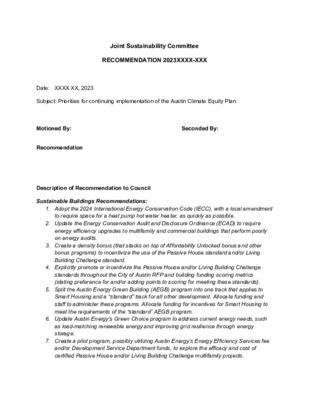7. Sustainable Buildings Working Group Draft Recommendations — original pdf
Backup

Joint Sustainability Committee RECOMMENDATION 2023XXXX-XXX Date: XXXX XX, 2023 Subject: Priorities for continuing implementation of the Austin Climate Equity Plan Motioned By: Seconded By: Recommendation Description of Recommendation to Council Sustainable Buildings Recommendations: 1. Adopt the 2024 International Energy Conservation Code (IECC), with a local amendment to require space for a heat pump hot water heater, as quickly as possible. 2. Update the Energy Conservation Audit and Disclosure Ordinance (ECAD) to require energy efficiency upgrades to multifamily and commercial buildings that perform poorly on energy audits. 3. Create a density bonus (that stacks on top of Affordability Unlocked bonus and other bonus programs) to incentivize the use of the Passive House standard and/or Living Building Challenge standard. 4. Explicitly promote or incentivize the Passive House and/or Living Building Challenge standards throughout the City of Austin RFP and building funding scoring metrics (stating preference for and/or adding points to scoring for meeting these standards). 5. Split the Austin Energy Green Building (AEGB) program into one track that applies to Smart Housing and a “standard” track for all other development. Allocate funding and staff to administer these programs. Allocate funding for incentives for Smart Housing to meet the requirements of the “standard” AEGB program. 6. Update Austin Energy’s Green Choice program to address current energy needs, such as load-matching renewable energy and improving grid resilience through energy storage. 7. Create a pilot program, possibly utilizing Austin Energy’s Energy Efficiency Services fee and/or Development Service Department funds, to explore the efficacy and cost of certified Passive House and/or Living Building Challenge multifamily projects. Recommend funding $3,000 per unit for first 1000 Low Income Housing Tax Credit (LIHTC) units to certify and create a report detailing construction cost increases vis a vis utility savings and other benefits. Rationale: Sustainable Building Recommendations 1. The 2024 International Energy Conservation Code (IECC) will result in more efficient residential and commercial building and will establish initial standards for electric-ready and EV-ready construction. These are important improvements that are called for in the Austin Climate Equity Plan and will reduce greenhouse gas emissions. Constructing buildings that are efficient and allow for electrification is more cost effective than retrofitting them later. This is a low-cost option for the city because builders would make the investments. It will also ultimately reduce costs for building owners and occupants. 2. The Energy Conservation Audit and Disclosure Ordinance (ECAD) was a good first step to raise awareness about the efficiency of buildings, but with high demand for housing and commercial real estate, disclosure of this information isn’t sufficient to result in improvements to buildings. It’s time to follow the lead of other cities, such as New York City, and require improvements when energy efficiency deficiencies are identified. This is a medium-cost option for the city because property owners would make the investments, likely with the help of existing incentives from Austin Energy. It will also ultimately reduce costs for building owners and occupants. 3. Passive House and the Living Building Challenge are robust energy efficiency standards. A bonus program that incentivizes builders to meet these more robust standards will benefit building occupants and help meet energy efficiency goals set in the Austin Climate Equity Plan and the Austin Energy Resource, Generation and Climate Protection Plan. This is a low-cost option for the city because builders would make the investments. It will also ultimately reduce costs for building owners and occupants. 4. The City of Austin should ensure that the highest energy efficiency and sustainable buildings standards are met for any project funded by the city. The Passive House and Living Building Challenge standards are robust standards that the city should require for public projects. 5. Austin’s Smart Housing program requires some buildings to achieve at least a three-star rating through the Austin Energy Green Building (AEGB) program. Because this is interpreted as a mandatory code by the city legal department, there are certain improvements - especially around excluding unhealthy and unsustainable building materials and fossil fuel use - that aren’t being made to the AEGB standards, out of concern that they may be prohibited by state law that applies to mandatory codes. There is much more freedom with voluntary codes, so splitting AEGB into two tracks - one that applies only to Smart Housing and one that is for all other builders who want to voluntarily meet the standard - will allow for the latter track to be improved without the same restrictions. These important programs need adequate funding and staffing to continue their success. 6. Austin Energy’s Green Choice program served an important need for many years by providing funding for additional wind energy contracts. Now, funds collected by program participants are used to slightly decrease the Power Supply Adjustment (PSA) fee. While specific wind projects are still designated as supplying Green Choice Participants, new projects aren’t procured based on program participation because Austin Energy already has such a large amount of wind generation in its portfolio. The current need is for renewable energy that is available at the times when Austin Energy customers are using energy, so purchasing or contracting for load-matching renewable energy and energy storage resources would be a good use of Green Choice funds. 7. Passive House and Living Building Challenge certified buildings provide safe, resilient housing options that use significantly less energy, especially at peak demand times and their initial costs are marginal. These buildings are being incentivized and even mandated in many cities and states across the continent. The pilot program we are recommending is intended to provide proof of concept examples and is modeled on a successful program in Massachusetts that has led to Passive House recently being adopted as code minimum for all multifamily projects above 12,000 sf. Vote For: Against: Abstain: Absent: Attest: [Staff or board member can sign]